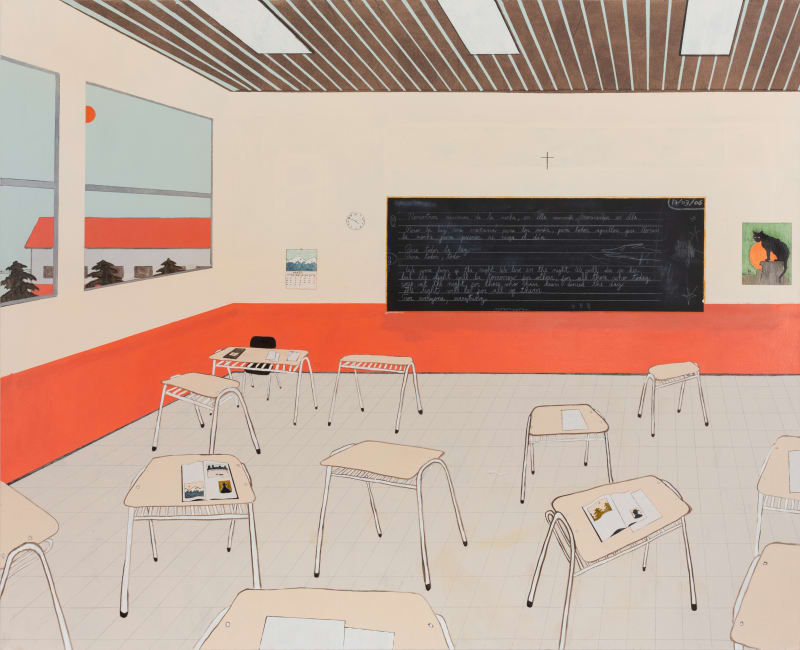Francisco Rodriguez’s urban interiors depict safe spaces, painted from memory without recourse to reference materials. The paintings are not perfectly remembered realities, but are recollections of his adolescence. The title references the secrets we keep behind closed doors and aptly describes the palpable silence that pervades the paintings. Its inspiration is taken from a 1947 painting by Matisse of the same name.
Many of Rodriguez’s scenes are devoid of people: barren and unpopulated. In Assembly (2021) the viewer is witness to an abandoned classroom. The tables are disordered and there is a striking absence of chairs. Chalk lingering on the blackboard, it seems as if the classroom has been hastily deserted. Rodriguez is passing comment on 2006, an important year for students in Chile as they rallied together to form a political movement against the last vestiges of Pinochet’s dictatorship. The chairs are in fact missing as they have been borrowed for a student union meeting, perhaps taking place just outside the classroom. The writing on the blackboard also references this time as an excerpt from the 1996 Manifesto Zapista has been written across it. The text reads:
"We were born of the night. We live in the night. We will die in her. But the light will be tomorrow for others, for all those who today weep at the night, for those who have been denied the day. The light will be for all of them. For everyone everything."
Therefore, what at first glance appears to be an abandoned classroom on closer inspection references a poignant moment from Rodriguez’s adolescence in Chile.
In The Silence That Lives In Houses (2021) Rodriguez re-imagines the living room from his childhood home. The furniture within is reduced to unmodulated plains of colour, its naiveté reminiscent of the Fauvist school. A cat treads cautiously across the floor: a reoccurring motif in his works. Rodriguez utilises the imagery of a cat to symbolise safety, whilst dogs prowling outside are the menacing antithesis. Much like a Japanese haiku, Rodriguez’s paintings are brimming with insinuations and ambiguous references that the viewer will inevitably attempt to piece together. Flat planes of colour and dark outlines of shapes within the paintings reference graphic animations and Japanese drawings: the latter a tradition that inspired many post-Impressionists.
The Twin Room (2021) is a painting containing multiple previous works by the artist, rendered in miniature size as posters hung on the bedroom walls. They serve as self-reflexive reminders of his continuously evolving visual language, creating a continuum between this new body of work and his previous paintings.
Such subtle references and imagery are hidden throughout Rodriguez’s paintings. In Apollo (The Drawing Lesson) (2021) for example, there is a sculpture of the Apollo Belvedere resting on a table. Long thought to embody aesthetic perfection in the West, Rodriguez’s inclusion of the Classical sculpture sits quietly mocking the students’ interpretations that now adorn the classroom walls. Again, the scene in Apollo is abandoned, devoid of students, who all seem to have left once more in a hurry.
Overall, Rodriguez’s works in The Silence That Lives In Houses are equally exquisite and intriguing. Loaded with subtle details, the numerous, somewhat disparate, references piece together to create a collage of the artist and, simultaneously, a wholly unique visual language.
The Silence That Lives In Houses is on view until October 15th 2021 at Cooke Latham Gallery, Battersea.
Rodriguez, born in 1989 in Santiago, Chile, lives and works in London having graduated from the Slade with an MFA in 2018. Rodriguez has exhibited internationally in group and solo shows and his work is included in the V&A Museum collection.

